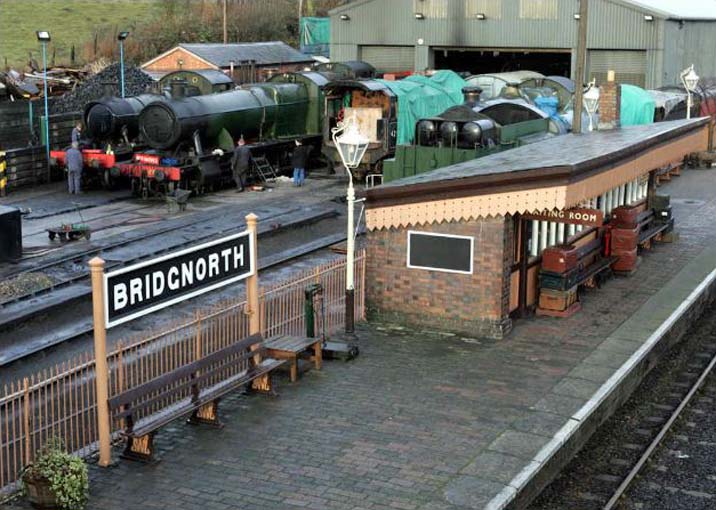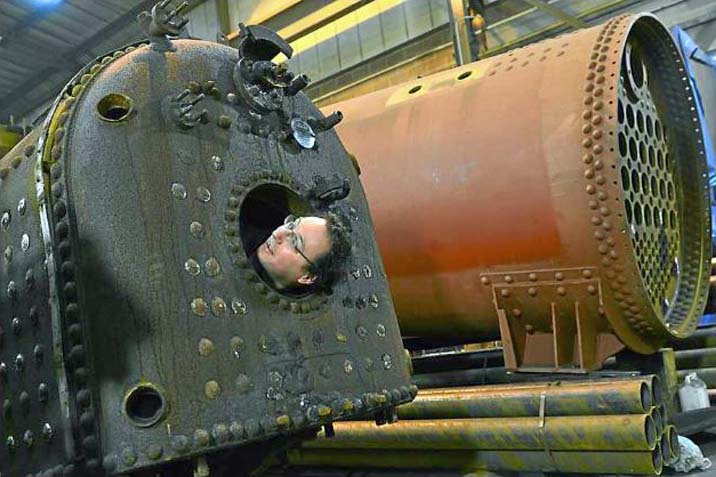Dave Howell pokes his head out of a boiler's firebox - Date/Photographer unknown. 13 January 2014 Work to Get Severn Valley Railway
on Track Kidderminster Worcestershire England United Kingdom - It's shutdown time on the Severn Valley Railway, which means now the work really begins.
It is the time of year that comes to us all, the new year urge to have a spring clean and put everything back in order.
And for staff and volunteers on the Severn Valley Railway it provides a six-week window to ensure everything is up to scratch as they prepare for another tourist season.
The shutdown of the line between Bridgnorth and Kidderminster has become an annual event.
It is essential for both the safety of passengers and to ensure that the immaculate condition of the engines, carriages, and stations is maintained.
And it also gives the volunteers the chance to get their hands dirty as they enjoy six weeks of "me time" with the heritage railway they love so much.
While it may seem nothing much is happening along the Bridgnorth to Kidderminster heritage line, behind the scenes it is all go.
The SVR has just completed its season of Santa Specials.
It now has a fixed period to complete all the necessary work before its next challenge, which will be to cater for families during the half-term holiday when the line reopens on 15 Feb 2014.
One of the busiest places is the workshop at Bridgnorth station where up to 30 volunteers are drafted in at any one time to give the locomotives their annual "MOTs".
The work can involve anything from stripping the pistons to a complete overhaul for the entire boiler.
Most of the time the volunteers, engineers, and boiler shop workers have no idea what will greet them until them have stripped the huge engines back to have a good look.
It is a centre of excellence in steam engine maintenance that finds itself in demand both from the Severn Valley Railway and elsewhere.
Duncan Ballard, 34, boiler shop and loco manager, who oversees the Bridgnorth site, said: "We service all the SVR locomotives and some also come in from as far as Wales and Scotland. We also get enquiries from overseas so that side has expanded. For five to six weeks the SVR is shut down, which is when we undertake maintenance work and examine all locomotives, on all our lines. It's like giving them all an MOT. A loco can stay on the track for a maximum of 10-years before the whole boiler has to be stripped back. We generally look at the valves, which need attention after travelling so many miles. We also look at the cylinders and pistons because as they heat up they lose efficiency. At the moment there are four in maintenance, three needing heavy repairs, and five boilers in the workshop. Some of the heavier work can take two years to complete and will cost in the region of £500,000. After 10 years a loco is given a boiler and mechanical repair, which can cost anything from £250,000 to £1 million. Anything that's running outside on the lines comes in to be repaired. We strip down tanks, which involves taking the boiler and all the wheels off, so they can be prepped ready to go back on the line."
Mr. Ballard, who has worked at the SVR for more than 10 years in two stints, said he had been interested in railways since his school days.
He lives in Bewdley, which boasts one of the line's most attractive stations.
As a youngster he got used to the sight, sound, and smell of the engines running through the town and he was bitten by the bug.
He said: "I grew up with it, there was a bit of Mickey-taking but there seems to be a renaissance in steam engines again now. I worked on everything to do with steam engines at the SVR and we also work on locomotives from other railway lines. Because volunteers are not involved in the operational side of things we encourage them to come back and help with the maintenance. We rely heavily on volunteers and there has been an upturn in the last 18 months. Sometimes we can have 20 to 30 volunteers and sometimes we have two, but we have a good band of people. Some like to come down to work on a particular engine. To be a volunteer you just need to be a member of the company."
Some of the country's most iconic locomotives currently reside in at the Bridgnorth station, with work picking up pace thanks in part of the SVR's share scheme, which has so far raised more than £2 million.
The scheme was set up in October 2012 to fund several projects along the heritage line and the £2 million milestone was greeted with a ceremony that saw the flagship engine, Hagley Hall number 4930, shunted from The Engine House Visitor Centre, in Highley, to the locomotive works.
The locomotive's restoration, which will cost about £400,000, is one of the key projects for the railway and is being supported by the share offer, as well as the SVR Charitable Trust and the Friends of Locomotive Hagley Hall Group.
The Hagley Hall locomotive was one of 259 "Hall" class engines built in Swindon and was seen as one of the most successful Great Western Railway designs, hauling both heavy freight and express passenger trains.
"The Hagley Hall has come in thanks to a share offer and will undergo heavy maintenance, which we will start this year," said Mr. Ballard.
"The Kinlet Hall, number 4936, has also come in and is the Hagley's sister train, meaning they came off the same production line in 1929. I was the chairman of the share group and it has helped speed up the process. We were always going to do the work on the Hagley Hall but now we can do it quicker. It hasn't been in service since 1986 but in one to two years it will be back up and running, which will increase the number of locomotives on the line and help with the flow. But just because an engine is the same it doesn't mean they will have the same problems. We won't know until we've stripped it back. We also launched our training programme through the share scheme and now have one trainee, who started a couple of weeks ago. We set up an academy and we'll put apprentices through all the different jobs available at the SVR, so they will have a qualification to work on any heritage line in the country."
Other trains currently undergoing maintenance at Bridgnorth include the Dunrobin, from the Beamish Museum, which was used by the Duke of Sutherland as his private locomotive.
The engine, which was build in the 1890s, was brought back to England three-years ago from Canada but has not run in country since the 1950s.
"We hope to get it back up and running early next year, when it will be transported by road back up to Beamish in County Durham," said Mr. Ballard.
"Moving a loco around can cost thousands of pounds. We had to make a whole new boiler for it, which we were not aware of before it came in. The copper has a reaction with the metal and causes electro-clinical chemical reaction, when mixed with water, which happens quite a lot."
The boiler room has also been filled as mechanics and engineers set about restoring the locomotives to their former glory.
"The boilers we have here are split 50-50 between those owned by the SVR and contract work," said Mr Ballard.
"This is really what I came back for. We have made new boilers here and we've got another one to start this year. A privately-owned boiler, Taw Valley, has been here since 2005 and will be completed this autumn."
The former Great Western Railway tank locomotive number 5164, which has been resident on the Bridgnorth to Kidderminster line since 1973, has also recently retired to the locomotive works.
It was built at Swindon in 1930 and will now undergo an overhaul after its 10-year boiler certificate expired.
As activity continued inside the SVR workshops, there is also much work to do outside.
Further infrastructure projects being carried out along the line over the next six weeks will see a third of a mile of track being re-laid north of Hampton Loade.
Engineers will also be rebuilding a collapsed drainage culvert in Alveley Woods.
It is all heavy work that involves a high level of expertise and is vital if the line is to remain up to scratch for the tens of thousands of tourists who flock there each year.
Every element of the experience for visitors has to be as authentic as possible.
And the attraction prides itself on the spotless appearance of its stations.
One of the biggest projects currently being undertaken is to rebuild 150 metres of platform one at Bridgnorth.
The scheme also includes the resetting of coping stones, stones on the platform edge, which slope slightly on platform two.
It is patient work that can be uncomfortable as the wind howls and the rain belts down.
But those involved don't seem to mind.
They are simply happy to be part of the Severn Valley Railway experience.
James Fisher.  Some of the facilities at Bridgnorth - Date/Photographer unknown. |


